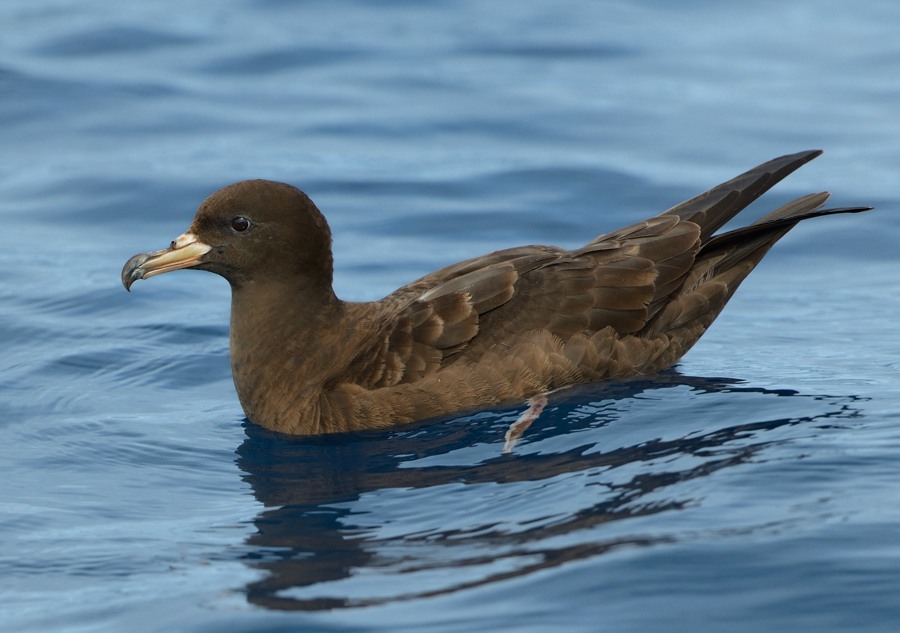At the Eleventh Meeting of ACAP’s Advisory Committee (AC11), held in Brazil in May this year, New Zealand reported that based on current listing prioritisation advice and knowledge of shared threats with other ACAP-listed species, it was considering the merit of nominating the globally Near Threatened and Nationally Vulnerable Flesh-footed Shearwater Ardenna carneipes for listing by ACAP. Flesh-footed Shearwaters are regularly caught as bycatch by commercial fisheries in New Zealand waters. The species has been previously identified by ACAP as a potential candidate species for such listing (see AC11 Inf 04).

Flesh-footed Shearwater at sea off New Zealand, photograph by Kirk Zufelt
Australia has considered whether the Flesh-footed Shearwater should be listed in its Environmental Protection and Biodiversity Conservation (EPBC) Act of 1999, following the species' nomination in 2012 (click here). After an assessment the decision was made in 2014 not to list the species, meaning that a recovery plan would not need to be produced (click here). Flesh-footed Shearwaters breed on Australia’s Lord Howe Island where they have decreased in numbers (and have been found to ingest large loads of plastic items), as well as on islands elsewhere in the country. The species also breeds on France’s St Paul Island in the southern Indian Ocean. Both Australia and France are Parties to ACAP.
Two globally threatened shearwaters, the Critically Endangered Balearic Puffinus mauretanicus and the Vulnerable Pink-footed A. creatopus, have already been listed by ACAP.
Access the AC11 report (see paragraph 14.5 on p. 18) here.
With thanks to Igor Debski.
References:
Baker, G.B. & Wise, B.S. 2005. The impact of pelagic longline fishing on the Flesh-footed Shearwater Puffinus carneipes in eastern Australia. Biological Conservation 126: 305-316.
Bond, A.L. & Lavers, J.L. 2015. Flesh-footed Shearwaters (Puffinus carneipes) in the northeastern Pacific Ocean: summary and synthesis of records from Canada and Alaska. Canadian Field-Naturalist 129: 263-267.
Cooper, J. & Baker, G.B. 2008. Identifying candidate species for inclusion within the Agreement on the Conservation of Albatrosses and Petrels. Marine Ornithology 36: 1-8.
Jamieson, S.E. & Waugh, S.M. 2015. An assessment of recent population trends of flesh-footed shearwaters (Puffinus carneipes) breeding in New Zealand. Notornis 62: 8-13.
Lavers, J.L. 2014. Population status and threats to Flesh-footed Shearwaters (Puffinus carneipes) in South and Western Australia. ICES Journal of Marine Science: 72: 316-327.
Lavers, J.L., Bond, A.L. & Hutton, I. 2014. Plastic ingestion by Flesh-footed Shearwaters (Puffinus carneipes): implications for fledgling body condition and the accumulation of plastic-derived chemicals. Environmental Pollution 187: 124-129.
Priddel, D., Carlile, N., Fullagar, P., Hutton, I. & O'Neill, L. 2006. Decline in the distribution and abundance of flesh-footed shearwaters (Puffinus carneipes) on Lord Howe Island, Australia. Biological Conservation 128: 412-424.
Reid, T., Hindell, M., Lavers, J.L. & Wilcox, C. 2013. Re-examining mortality sources and population trends in a declining seabird: using Bayesian methods to incorporate existing information and new data. PLoS ONE 8(4): e58230. doi:10.1371/journal.pone.0058230.
Taylor, G.A. 2000. Action plan for seabird conservation in New Zealand, Part B: Non-threatened seabirds. Threatened Species Occasional Publication No. 17. Wellington: Department of Conservation. pp. 357-360.
Taylor, G.A. 2013. Flesh-footed Shearwater. In: Miskelly, C.M. (Ed.). New Zealand Birds Online.
Waugh, S.M., Patrick, S.C., Filippi, D.P., Taylor, G.A. & Arnould, J.P.Y. 2016. Overlap between flesh-footed shearwater Puffinus carneipes foraging areas and commercial fisheries in New Zealand waters. Marine Ecology Progress Series 551: 249-260.
John Cooper, ACAP Information Officer, 17 June 2019

 English
English  Français
Français  Español
Español